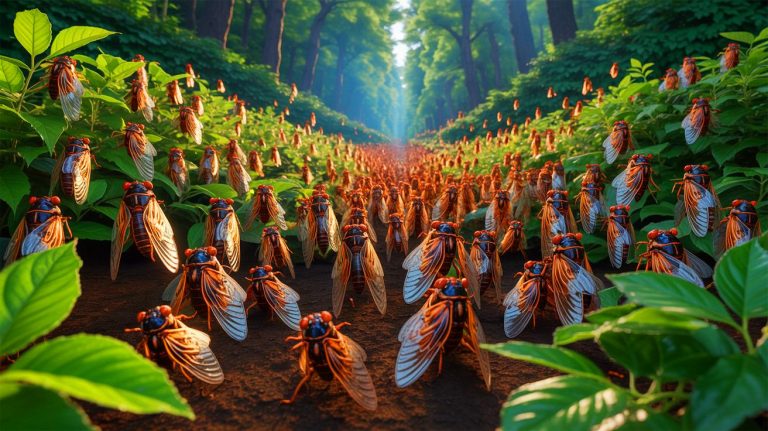| IN A NUTSHELL |
|
In a natural spectacle that occurs only once every 17 years, billions of periodical cicadas are set to surface across the United States, marking a rare event that captivates both scientists and the general public. This phenomenon involves Brood XIV, one of the largest and most significant cicada broods in the country. From mid-May to June, these insects will transform landscapes with their sheer numbers and deafening calls, a result of their synchronized emergence after spending nearly two decades underground. This article delves into the fascinating life cycle of these insects, their ecological impact, and the challenges posed by climate change.
The Life Cycle of Brood XIV
Brood XIV is a cohort of periodical cicadas that emerges every 17 years in regions primarily spanning the Midwest, Northeast, and Southeast United States. First documented in 1634, this brood is considered one of the original groups of 17-year cicadas. These insects spend most of their lives underground, feeding on tree roots in a larval stage known as nymphs. Their development is meticulously timed, as they wait for the soil temperature to reach 64 degrees Fahrenheit to begin their ascent to the surface.
Upon emergence, male cicadas engage in an elaborate mating ritual, producing loud, high-pitched calls to attract females. The noise can reach levels over 100 decibels, comparable to the sound of a jackhammer. After mating, females lay their eggs in tree branches, and within weeks, the adult cicadas die. Their decomposing bodies contribute essential nutrients to the soil, aiding in nutrient cycling. The newly hatched nymphs then burrow back underground, restarting the 17-year cycle.
A Survival Strategy
Periodical cicadas, including those in Brood XIV, employ a unique survival strategy known as predator saturation. By emerging in massive numbers simultaneously, they overwhelm predators such as birds, raccoons, and snakes. This strategy ensures that enough cicadas survive to reproduce, even though many fall prey to predators. This remarkable adaptation has fascinated scientists and the public alike, as it showcases the intricate balance of nature.
According to Dr. Chris Simon, an expert in ecology and evolutionary biology, the synchronized emergence and sheer numbers of cicadas have captivated people for centuries. The phenomenon is not only a marvel of natural timing but also a vital ecological event. Once the mating season is over, the cicadas’ bodies enrich the soil, creating a burst of fertility that benefits trees and other vegetation.
Ecological Impact: Balance or Disruption?
The emergence of Brood XIV brings both benefits and challenges to ecosystems. On one hand, the abundance of cicadas provides a temporary boost in food sources for wildlife, supporting increased populations of birds and other predators. Furthermore, the nutrient-rich bodies of dead cicadas enhance the fertility of soils, promoting plant growth.
However, this sudden influx of cicadas can also disrupt ecological balance. The elevated predator populations may result in a decrease in other prey species, such as caterpillars, potentially leading to unintended consequences for vegetation. Moreover, climate change poses a significant threat, as rising soil temperatures could alter the timing of cicada emergences. Scientists are particularly concerned about the phenomenon of ‘straggling,’ where cicadas emerge out of sync, potentially weakening their predator saturation strategy.
“Nature’s hidden empire”: This massive, fungus-like organism could redefine the entire tree of life
Looking Ahead: The Future of Brood XIV
As Brood XIV emerges in states including Georgia, South Carolina, Tennessee, Kentucky, Ohio, Indiana, Illinois, Missouri, and across Pennsylvania into New England, scientists are monitoring the event closely. The next anticipated emergence of this brood is in 2041, offering a window into the future of periodical cicadas in the face of environmental changes.
While current observations suggest that Brood XIV is on schedule, the impact of climate change remains a concern. Rising temperatures could lead to earlier emergences, altering the ecological dynamics that have evolved over centuries. The question remains: how will these changes affect the delicate balance of ecosystems that rely on these extraordinary insects?
As cicadas fill the air with their buzzing calls, they remind us of the astonishing cycles of life that unfold in the natural world. The emergence of Brood XIV offers an opportunity to witness a rare and remarkable event, one that sparks curiosity and underscores the intricate connections within ecosystems. How will future generations of cicadas adapt to an ever-changing environment, and what can we learn from their enduring life cycle?
Did you like it? 4.4/5 (29)










Are these cicadas dangerous to humans in any way? 🧐
Wow, 17 years underground! That’s some patience. 😮
Can anyone confirm if the cicada calls are actually louder than a jackhammer? Seems hard to believe.
This is a great opportunity for scientists to study climate change impacts on insect life cycles. Thank you for the detailed article!
How does climate change really affect these cicadas? I feel like we blame climate for everything nowadays. 🤔
Will the cicada swarm reach Texas? My backyard could use some extra nutrients.
I remember the last emergence when I was a kid. The noise was incredible!
How do cicadas know when 17 years have passed? Fascinating creatures! 📅
I’m excited to see this in person. Nature’s wonders never cease to amaze me. 🌿
Do these cicadas have any predators that might be in danger of overpopulation due to the sudden food source?
Amazing read! Can’t wait for the documentary on this event. 🎥
Is there any way to mitigate the noise or do we all just have to live with it for a while? 😅
Has anyone else noticed that cicadas always emerge during election years? Coincidence? 🤔
I love how nature organizes these incredible events. Truly a spectacle to behold! 🌍
Thanks for the heads up! Time to invest in some earplugs, I guess. 😂
I wonder if this will affect local agriculture at all? Any farmers here who can weigh in?
Great article, but I’m worried about my dog eating these cicadas. Are they safe for pets?
What are scientists doing to protect these cycles from climate change? Seems like a big challenge.
17 years is a long time. How do these cicadas survive underground all that time?
I’ve read that cicadas taste like shrimp. Has anyone tried them? 🍤
Is there a map available showing where the cicada emergence will be most intense?
Why do we only hear about cicadas every 17 years? Are there other broods on different cycles?
Thank you for such an informative piece. It’s great to learn about these fascinating insects!
Does the noise affect humans in any harmful way, like causing stress or hearing damage?
I’m looking forward to seeing how this affects local wildlife populations. Nature’s balance is so intricate! 🐦
I had no idea cicadas could contribute so much to soil fertility. Nature’s recyclers! ♻️
How do cicadas survive being underground for so long without any light?
I think it’s funny how something as small as a cicada can cause such a big buzz, pun intended. 😂
It’s so unfortunate that journalism needs to have fantastically worded headlines to just move a small story forward.
“Biblical swarm”, ,really needed?
It was only 17 years ago it happened, just like it will in 17 more years. Are there any reliable editors anymore who can restart accurately written news?